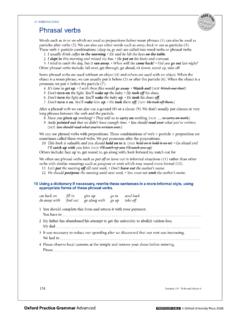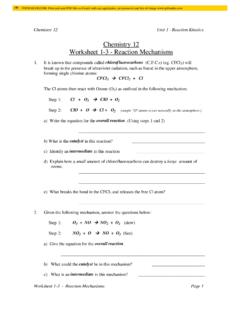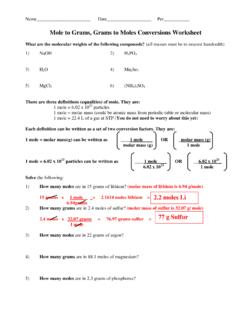Transcription of Ideal Gas Law Name Chem Worksheet 14-4
1 Ideal Gas Law Name _____. Chem Worksheet 14-4. The Ideal gas law is an equation that relates the volume, temperature, pressure and amount of gas particles to a constant. The Ideal gas constant is abbreviated with the variable R and has the value of atm L/mol K. The Ideal gas law can be used when three of the four gas variables are known. When using this equation it is important that the units for pressure are atmospheres (atm), volume is in liters (L), and temperature is converted to kelvins (K). The amount of gas is measured in units called moles (mol). Unknown Equation Known Variables nRT. USEFUL EQUATIONS pressure P= amount, temp., volume V. PV = nRT atm = 101300 Pa nRT.
2 Atm L. R = mol atm = kPa volume V= amount, temp., pressure K P. TK = TC + 273 atm = 760 mmHg 1 cm3 = 1 mL atm = 760 torr PV. temperature T= pressure, volume, amount nR. 1 L = 1000 mL atm = psi PV. amount n= pressure, volume, temp. RT. example The pressure exerted by moles of argon gas at a temperature of 85 C is 420 torr. What is the volume of this sample? atm L. - list the variables: P = 420 torr V=? n = mol R = mol K T = 85 C. - convert the variables: 420 torr 1 atm T = 85 C + 273 = 358 K. = atm 1 760 torr atm L. nRT ( mol)( mol K. )(358 K). - substitute into the equation: V= V= = 82 L. P atm Solve the following problems. 1. A tank contains 115 moles of neon gas.
3 It has a pressure of 57 atm at a temperature of 45 C. Calculate the volume of the tank. 2. A scuba tank has a pressure of 195 atm at a temperature of 10 C. The volume of the tank is 350 L. How many moles of air are in the tank? 3. A helium-filled balloon has a volume of 208 L and it contains moles of gas. If the pressure of the balloon is atm, determine the temperature in Celsius degrees. 4. A tank of oxygen has a volume of 1650 L. The temperature of the gas inside is 35 C. If there are 9750 moles of oxygen in the tank what is the pressure in PSI? 5. A canister of acetylene has a volume of 42 L. The temperature of the acetylene is 305 K and the pressure is 780 torr.
4 Determine the amount (moles) of gas in the canister. 6. Calculate the volume of a CO2 cartridge that has a pressure of 850 PSI at a temperature of 21 C. The cartridge contains mol of CO2. 7. A tank contains 2500 L of argon gas. The pressure is13790 kPa and the temperature is 25 C. How many moles of argon are in the tank? John Erickson, 2005 WS14-4 IdealGasLaw

















